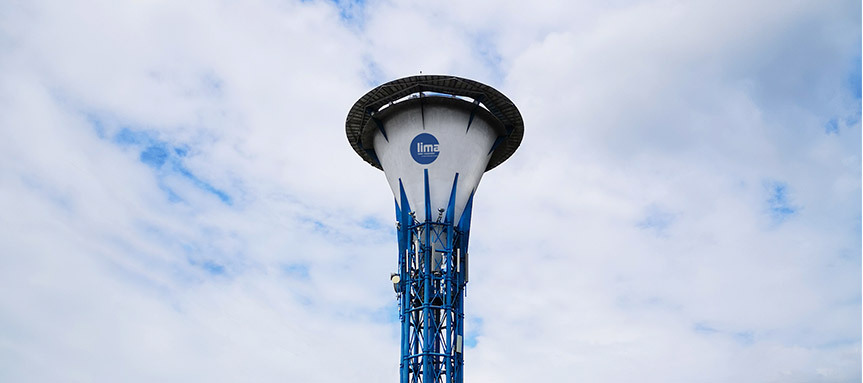Home /
Water infrastructure: Foundations of sustainable development
Water infrastructure is an often overlooked aspect of development, particularly for those who already live in areas with reliable access to clean water. However, without up-to-date water collection, treatment, and distribution systems, sustained human activity would be hazardous, if not impossible.
Coming into the 21st century, the Philippines faced a divide in the delivery of vital water and sanitation services, with many areas in the countryside experiencing regular shortages despite the country’s wealth of water resources. Thanks to Aboitiz InfraCapital (AIC) and other development partners, this divide is closing fast.
The Philippines is currently striving to provide universal, safe, and equitable water access for all Filipinos by the year 2030. This is an ambitious goal, especially given the country’s current challenges with an increasing population, aging water systems, and climate change. With the conscientious application of new methods and technologies, the country’s next generation of water infrastructure will be well-suited to meet those challenges.
Aboitiz InfraCapital has had years of experience developing sustainable water infrastructure in the Philippines, serving both local communities as well as AIC’s own economic estates. Wherever Aboitiz water infrastructure developments are completed, connected communities benefit from better water quality and availability. AIC’s water infrastructure projects and investments have thus empowered communities and businesses to thrive and create value for the entire country.
Our Projects and Investments

Apo Agua Infrastructura, Inc.
Location: Davao City, Philippines
Learn More Apo Agua Infrastructura, Inc.

Balibago Waterworks System, Inc.
Minority Stake
Locations: Aurora, Batangas, Benguet, Bohol, Bulacan, Cavite, Davao Del Norte, Davao Del Sur, Davao Oriental, Ilocos Sur, Iloilo, La Union, Laguna, Nueva Ecija, Nueva Vizcaya, Pampanga, Pangasinan, Sarrangani, Tarlac, and Zamboanga Sibugay, Philippines
Aboitiz InfraCapital Water Infrastructure - FAQs
What is water infrastructure?
Water infrastructure collectively refers to the man-made components of systems used to pump, store, divert, transport, and treat water for human use and consumption. Water infrastructure components can also include dams, reservoirs, desalination plants, waste treatment facilities, drinking water treatment plants, pipes, irrigation systems, and anything else built for the purpose of making clean water available to communities.
AIC draws upon its years of experience in water system development to build new water infrastructure in previously unserved areas or to further develop existing water system assets in areas that require more capacity or more consistent service. It uses novel, award-winning solutions to not only improve water service levels but also lay the foundations for sustainable water security in the long term.
Water infrastructure by AIC also builds on the lessons learned from previous generations of water system technology and management practices. Current water infrastructure development projects not only aim to solve immediate problems but they are also intended to leave a lasting legacy that continues to make a positive impact on the lives of future generations of Filipinos.
How important is water infrastructure?
When most people hear the word “infrastructure,” the first things that often come to mind are roads, bridges, power plants, airports, seaports, or railways. While these assets are crucial for nation-building, water infrastructure is just as important, if not more so. It just so happens that, unlike other infrastructure assets, the components that comprise water systems are largely hidden from view. One can easily see roads, bridges, and railways but pipes and water treatment facilities are mostly located underground or in out-of-the-way areas.
This hidden water infrastructure brings clean water into homes and businesses, allowing life as we know it to exist. It also helps keep people healthy, allowing them to create value for the country by way of supporting human capital. Water infrastructure also protects the environment by preventing the degradation of ecosystems and permitting the sustainable use of natural resources.
By understanding the value of water infrastructure, we can help ensure that these unseen yet vital assets continue to receive adequate investment for decades to come.
What are the biggest challenges to Philippine water infrastructure development?
According to a 2013 paper published by the Asian Development Bank, Philippine water security, and by extension, water infrastructure is beset by a few serious challenges. One major issue is climate change, which has already resulted in the rapid decrease of readily available freshwater resources. Another issue is that overall water coverage has not kept up with the country’s rapidly increasing population. Lastly, there is a critical lack of effective sewerage, with most homes in the country still using either leak-prone septic tanks or simply discharging effluent into the environment, degrading the quality of available water sources.
Thankfully, much progress has been made to mitigate these issues, thanks to the efforts of the Philippine national government, local government units, and private development partners such as Aboitiz InfraCapital.
How is Aboitiz InfraCapital meeting these challenges?
All water infrastructure development projects by AIC are made to help address the root causes of local water security issues. Cutting-edge technologies are adopted for local settings to ensure that system inefficiencies and wastewater pollution are mitigated at every possible point in the water supply chain, resulting in more responsive service and an always-adequate supply of water.
AIC is already demonstrating the future of what’s possible in Philippine water infrastructure on its economic estates. Lima Water Corporation (LWC), an Aboitiz InfraCapital subsidiary, offers world-class end-to-end water services for locators at the LIMA Estate, an 800-hectare PEZA-registered economic zone — the largest of its kind in the Philippines. LWC offers the whole gamut of water services for LIMA Estate’s 143 locators, over 4,000 households, and 65,000 employees.
Everything from production, distribution, and wastewater treatment at LIMA Estate is handled by LWC using modern monitoring and automation technologies. The result is a highly efficient and environmentally sustainable operation that not only meets all the estate’s needs but also significantly reduces costs compared to service areas employing legacy water infrastructure.
The successes of LWC are already on track to be replicated in many parts of the Philippines. Through its minority stake in Balibago Waterworks System, Inc. (BWSI), AIC has become a key component in the venture’s success in improving water utilities throughout the country.
These and other water infrastructure projects demonstrate that Aboitiz InfraCapital has access to the technologies, expertise, and experience needed to tackle the country’s water supply, coverage, and sanitation issues.
How does Aboitiz InfraCapital offer world-class water infrastructure?
AIC is a core part of the Aboitiz Group, one of the most trusted business conglomerates in the Philippines. Between them, the many business units of the Aboitiz Group have decades of experience not just in water infrastructure development but also in other sectors like energy, logistics, finance, real estate, and more. Additionally, companies in the Aboitiz Group, including AIC, have extensive partnerships with domestic and foreign firms that are also leaders in their respective fields.
This gives the Aboitiz Group a unique ability to not only leverage technology and expertise from all over the world, but also to readapt and scale solutions that have worked elsewhere in various Philippine settings. This, in turn, gives AIC the edge when it comes to delivering high-quality, technology-driven water infrastructure solutions.
How many Aboitiz InfraCapital water infrastructure projects are there?
At present, there are currently three major Aboitiz InfraCapital water infrastructure projects and investments. These include the following:
Apo Agua Infrastructura
In Davao City, Apo Agua Infrastructura, Inc. the largest operating private bulk water supply facility in the country, provides the Davao City Water District with 300 million liters of safe drinking water daily, serving over one million Davaoeños.
Lima Water Corporation (LWC)
Lima Water Corporation (LWC) is a water services provider that is fully owned by Aboitiz InfraCapital. It primarily serves AIC’s 800-hectare LIMA Estate, a large planned estate and community with 65,000 employees and over 4,000 households.
Unique for a Philippine water utility company, LWC provides end-to-end services to an entire economic estate —from production to distribution and waste management. It produces 10.5 million liters of water per day and has a wastewater treatment capacity of 26 million liters per day. LWC also serves as a reference for Aboitiz InfraCapital’s other water infrastructure projects as well as a test bed for water system technologies.
Balibago Waterworks System, Inc. (BWSI)
Aboitiz InfraCapital also owns a minority stake in Balibago Waterworks Systems, the country’s fourth-largest private water utility distributor, providing running water to over 330,000 households in its franchise area.
How does AIC’s sustainability framework influence its water infrastructure projects?
All of Aboitiz InfraCapital’s activities are guided by a unique sustainability framework that equally emphasizes the Three Ps: People, Planet, and Profit. The framework is designed as a basis to help AIC’s decision-makers set goals and create lasting value. As such, all AIC water infra projects are developed with the environment and all stakeholders in mind.
Aboitiz InfraCapital projects are conceptualized to not only solve current water capacity problems but to do them in a way that benefits communities, employees, shareholders, and surrounding ecosystems. The execution and maintenance of these projects are similarly guided under the same framework.

